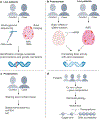Functional genomics and systems biology in human neuroscience
- PMID: 37938705
- PMCID: PMC11465930
- DOI: 10.1038/s41586-023-06686-1
Functional genomics and systems biology in human neuroscience
Abstract
Neuroscience research has entered a phase of key discoveries in the realm of neurogenomics owing to strong financial and intellectual support for resource building and tool development. The previous challenge of tissue heterogeneity has been met with the application of techniques that can profile individual cells at scale. Moreover, the ability to perturb genes, gene regulatory elements and neuronal activity in a cell-type-specific manner has been integrated with gene expression studies to uncover the functional underpinnings of the genome at a systems level. Although these insights have necessarily been grounded in model systems, we now have the opportunity to apply these approaches in humans and in human tissue, thanks to advances in human genetics, brain imaging and tissue collection. We acknowledge that there will probably always be limits to the extent to which we can apply the genomic tools developed in model systems to human neuroscience; however, as we describe in this Perspective, the neuroscience field is now primed with an optimal foundation for tackling this ambitious challenge. The application of systems-level network analyses to these datasets will facilitate a deeper appreciation of human neurogenomics that cannot otherwise be achieved from directly observable phenomena.
© 2023. Springer Nature Limited.
Conflict of interest statement
Figures


References
Publication types
MeSH terms
Grants and funding
LinkOut - more resources
Full Text Sources
Miscellaneous

